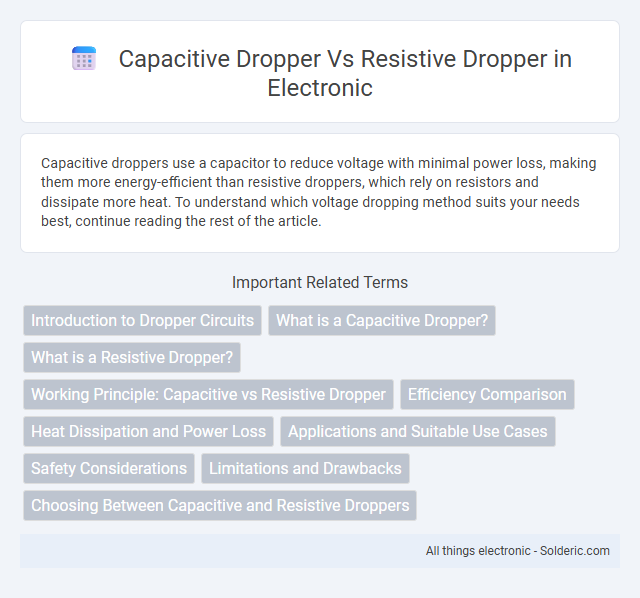Capacitive droppers use a capacitor to reduce voltage with minimal power loss, making them more energy-efficient than resistive droppers, which rely on resistors and dissipate more heat. To understand which voltage dropping method suits your needs best, continue reading the rest of the article.
Comparison Table
| Feature | Capacitive Dropper | Resistive Dropper |
|---|---|---|
| Principle | Uses capacitive reactance to limit current | Uses resistance to reduce current flow |
| Power Loss | Low power dissipation | High power dissipation (heat) |
| Size | Compact, smaller components | Bulky resistors required for high power |
| Efficiency | High efficiency due to reactive component | Lower efficiency due to resistive loss |
| Heat Generation | Minimal heat generated | Significant heat generated |
| Cost | Moderate, capacitor-based | Low, uses standard resistors |
| Safety | Requires careful design for isolation | Safer, but may require heat sinks |
| Application | Low-power LED drivers, small AC circuits | Simple current limiting, low voltage drops |
| Frequency Dependence | Dependent on AC frequency | Frequency independent |
Introduction to Dropper Circuits
Dropper circuits are essential for reducing voltage levels in electronic devices, with capacitive and resistive types serving distinct applications. A capacitive dropper uses a capacitor to limit current without significant power loss, offering efficiency and compactness for low-power AC applications. Your choice between capacitive and resistive droppers depends on factors like power dissipation, size, and safety requirements in the circuit design.
What is a Capacitive Dropper?
A capacitive dropper is a type of power supply circuit that uses a capacitor to reduce voltage instead of resistors, enabling energy-efficient current limitation in low-power applications. Unlike resistive droppers that dissipate power as heat, capacitive droppers rely on the capacitive reactance to limit current, making them ideal for compact, low-cost, and energy-saving designs. This method is commonly used in LED drivers, small appliances, and electronic circuits where space and efficiency are critical.
What is a Resistive Dropper?
A Resistive Dropper is a simple electrical component that uses a resistor to reduce voltage in a circuit by dissipating power as heat. Unlike capacitive droppers, which rely on reactance to limit current without generating heat, resistive droppers are less energy-efficient due to continuous power loss. Understanding this difference can help you choose the right voltage dropping method for your electronic applications.
Working Principle: Capacitive vs Resistive Dropper
A capacitive dropper reduces voltage using the reactance of a capacitor to limit current flow without dissipating significant power, making it energy-efficient for low-power applications. In contrast, a resistive dropper relies on a resistor to convert excess voltage into heat, resulting in energy loss and lower efficiency. Understanding these working principles helps you choose the right voltage regulation method for your circuit's power and efficiency requirements.
Efficiency Comparison
Capacitive droppers offer higher efficiency compared to resistive droppers by minimizing power dissipation through reactive components instead of resistive elements. Resistive droppers convert excess voltage into heat, resulting in significant energy loss and lower overall efficiency. Your choice of a capacitive dropper can improve energy savings and reduce thermal management needs in low-power applications.
Heat Dissipation and Power Loss
Capacitive droppers generate significantly less heat dissipation compared to resistive droppers, as they rely on reactance rather than resistance to limit current, resulting in lower power loss. Resistive droppers convert excess voltage into heat through resistance, causing higher thermal energy and inefficiency in power usage. Your choice between these dropper types directly impacts energy efficiency and thermal management in low-power electronic circuits.
Applications and Suitable Use Cases
Capacitive droppers are ideal for low-power applications such as LED night lights, small sensors, and electronic doorbells where efficiency and compact size are essential. Resistive droppers suit high-current, low-voltage devices like heating elements and simple motor controls due to their simplicity and reliability under varying load conditions. Capacitive droppers excel in reducing power dissipation, while resistive droppers provide stable current limiting in rugged environments.
Safety Considerations
Capacitive droppers rely on non-dissipative reactance for voltage reduction, minimizing heat generation and improving energy efficiency but necessitate careful insulation and component rating to prevent electric shock due to direct connection to AC mains. Resistive droppers dissipate energy as heat, which can lead to overheating, making thermal management and fuse protection critical for safety. Both methods require proper design to ensure compliance with electrical safety standards and to prevent fire hazards or electric shock risks.
Limitations and Drawbacks
Capacitive droppers face limitations such as reliance on AC mains frequency and voltage, resulting in non-isolated, voltage-dependent current with potential safety hazards due to lack of galvanic isolation. Resistive droppers suffer from significant power dissipation as heat, leading to low energy efficiency and the need for larger resistors to handle high power loads, which increases size and cost. Both methods provide limited current regulation and are unsuitable for high-precision or high-power applications.
Choosing Between Capacitive and Resistive Droppers
Choosing between capacitive and resistive droppers depends on factors like efficiency, heat dissipation, and size constraints. Capacitive droppers provide better energy efficiency and generate less heat by using reactance, making them ideal for compact, low-power applications. Your selection should consider the specific voltage drop, power requirements, and thermal management capabilities to optimize performance and safety.
Capacitive dropper vs Resistive dropper Infographic

 solderic.com
solderic.com